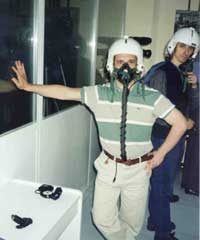
Chemists put biological catalysts to work in clean industrial solvents.
In a move towards cleaner chemical processing, researchers in Spain and France have worked out how to use enzymes as catalysts using two ’green’ solvents: one to dissolve the enzyme, the other to dissolve the materials it transforms.
In some industrial processes chemists have replaced polluting organic solvents, such as chlorine and benzene, with supercritical carbon dioxide. This is the liquid

Research chemists have a found a class of synthetic molecules that could quite literally act as a key which could lock away sections of DNA into a closely wound coil preventing proteins from interacting with particular sections of DNA code. By locking up the DNA in this way scientists could stop particular sequences of DNA from activating biological changes that doctors or scientists would rather avoid, or wish to regulate closely.
Until now researchers trying to devise synthetic molecules t

A team of researchers from the Universitat Autònoma de Barcelona, in coordination with the Instituto Nacional de Técnica Aerospacial Esteban Terradas (INTA – Esteban Terradas National Institute of Aerospace Technology), is preparing for a person to jump from an altitude of 38,000 metres, on the edge of the stratosphere. This will be the highest altitude from which anybody has ever jumped, allowing for the first ever studies of human behaviour in such an extreme situation.
Parachutist Miguel

The first steps in a new method of detecting landmines by determining the presence of tiny quantities of the explosive TNT (trinitrotoluene) are described in research published today in the Institute of Physics publication Journal of Physics D. Markus Nolte, Alexei Privalov and Franz Fujara of Darmstadt Technical University in Germany, together with Jurgen Altmann of Dortmund University and Vladimir Anferov from the Kalingrad State University in Russia, describe in the journal how they have devised a

Over-the-counter cough medicines could give early warning of bioterrorism.
Tracking over-the-counter sales of cough medications for unseasonable surges could be a way of spotting imminent anthrax epidemics, say US researchers 1 .
In the wake of the 11 September terrorist attacks in the United States, scientists are working on ways to detect a biological attack quickly and so minimize its effects. Because a sore throat and cough are the first symptoms of anthra

Invading insect empire stretches 6,000 kilometres.
An invading empire has conquered Europe. One super-colony of South American ants, with millions of nests and billions of individuals, stretches 6,000 kilometres around the Mediterranean and Atlantic coasts, researchers have found.
Every ant in the colony treats every other as its nest-mate – even though they may be quite unrelated. The nests have buried their differences to create the largest cooperative unit ever discovered

– new calculation confirms standard model of particle physics. Contribution of hadronic vacuum polarization determined with unprecedented accuracy. The magnetic moment of the muon is an important precision parameter for…
Technique may prevent formation of unwanted waves that siphon off needed energy. Heating plasma to the ultra-high temperatures needed for fusion reactions requires more than turning the dial on a…

An international team of astronomers, led by researchers from the Astronomical Observatory of the University of Warsaw, have identified a new class of cosmic X-ray sources. The findings have been…

Antibody that Neutralizes Inhibitory Factors Involved in Nerve Regeneration Leads to Enhanced Motor Function after Acute Spinal Cord Injury. Researchers at 13 clinics in Germany, Switzerland, the Czech Republic and…

How the body’s natural killer cells could fight leukemia. Every year, some 13,000 people in Germany are diagnosed with leukemia. Despite intensive chemotherapy, around one in two of them die….

… eco-friendly reactor converts air and water into ammonia. Producing enough ammonia to feed the world comes with a large carbon footprint;. process described in new UB-led study could help…

How simulations help manufacturing of modern displays. Modern materials must be recyclable and sustainable. Consumer electronics is no exception, with organic light-emitting diodes (OLEDs) taking over modern televisions and portable…

“Neurons that fire together, wire together” describes the neural plasticity seen in human brains, but neurons grown in a dish don’t seem to follow these rules. Neurons that are cultured…

The quest for sustainable energy solutions has been a major focus of scientific research for decades. Solar energy, a clean and renewable source, has emerged as a promising alternative to…

With a processing speed a billion times faster than nature, chip-based laser neuron could help advance AI tasks such as pattern recognition and sequence prediction. Researchers have developed a laser-based…

New technology could remotely identify various types of plastics, offering a valuable tool for future monitoring and analysis of oceanic plastic pollution. Researchers have developed a new hyperspectral Raman imaging…

Artificial Intelligence (AI) has established a strong presence across industries, large and small. The “VoBaKI” research project has empowered small and medium-sized enterprises (SMEs) with an innovative tool to independently…